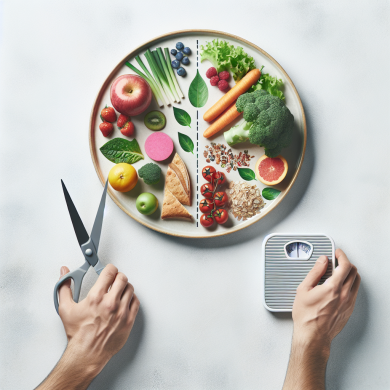Top Low-Calorie Protein Sources Uncovered
Introduction
In the journey towards fitness and health, protein plays a pivotal role. It is essential not only for building and repairing tissues but also for producing enzymes and hormones. However, for those who aim to lose weight or maintain a lean physique, it’s crucial to incorporate low-calorie protein sources into their diet. Balancing protein intake with calorie control can be challenging, but it is achievable with the right choices. This article delves into the best low-calorie protein sources that can help you achieve your dietary goals without compromising on nutrition.
The Importance of Protein in a Low-Calorie Diet
Protein is a macronutrient that is essential for various bodily functions. It supports muscle growth, aids in weight management by increasing satiety, and helps maintain a healthy metabolism. In a low-calorie diet, the challenge is to consume enough protein to meet these needs without exceeding calorie limits. Selecting protein sources that are low in calories but high in nutritional value is key to sustaining a healthy diet.
Top Low-Calorie Protein Sources
1. White Fish
White fish, such as cod, haddock, and tilapia, are excellent low-calorie protein sources. They are rich in high-quality protein and have minimal fat content. For example, a 3-ounce serving of cod contains approximately 90 calories and 20 grams of protein, making it an ideal choice for those watching their calorie intake. Additionally, white fish is a good source of essential nutrients like vitamin B12 and selenium.
2. Chicken Breast
Chicken breast is a staple in many diets due to its high protein content and low-calorie profile. A 3-ounce serving of skinless, boneless chicken breast contains about 140 calories and 26 grams of protein. It is versatile, easy to prepare, and can be flavored with various herbs and spices to suit different tastes. Chicken breast is also low in saturated fat, making it a heart-healthy protein option.
3. Greek Yogurt
Greek yogurt is not only creamy and delicious but also an excellent source of protein. A 6-ounce serving of non-fat Greek yogurt provides around 100 calories and 17 grams of protein. It is lower in sugar compared to regular yogurt and is rich in probiotics, which promote gut health. Greek yogurt can be enjoyed on its own, with fruit, or as a healthy topping for various dishes.
4. Egg Whites
Egg whites are a pure protein source, with nearly no fat or carbohydrates. One large egg white contains approximately 17 calories and 4 grams of protein. They can be used in a variety of recipes or simply cooked as a low-calorie omelet. Egg whites are an excellent choice for individuals looking to increase protein intake without adding many calories.
5. Tofu
Tofu is a plant-based protein source made from soybeans. It is incredibly versatile and can be used in both savory and sweet dishes. A half-cup serving of firm tofu contains about 94 calories and 10 grams of protein. Tofu is also rich in calcium, iron, and other essential nutrients. It serves as a great protein substitute for vegetarians and vegans.
6. Lentils
Lentils are a legume that offers a significant amount of protein and fiber with relatively low calories. A half-cup serving of cooked lentils provides about 115 calories and 9 grams of protein. They are also an excellent source of iron, folate, and other important vitamins and minerals. Lentils can be used in soups, salads, or as a meat substitute in various dishes.
7. Cottage Cheese
Cottage cheese is a dairy product that is high in protein and low in calories. A half-cup serving of low-fat cottage cheese contains approximately 90 calories and 11 grams of protein. It is also a good source of calcium and can be consumed on its own or used in a variety of recipes. Cottage cheese is an excellent choice for a high-protein snack or meal ingredient.
8. Edamame
Edamame, or young soybeans, are a nutritious and low-calorie protein source. A half-cup serving of shelled edamame contains around 120 calories and 11 grams of protein. They are also rich in fiber, vitamins, and minerals, making them a healthy addition to any diet. Edamame can be enjoyed as a snack or added to salads and stir-fries.
9. Shrimp
Shrimp is a seafood option that is high in protein and low in calories. A 3-ounce serving of cooked shrimp provides about 84 calories and 20 grams of protein. Shrimp is also an excellent source of selenium and vitamin B12. It can be used in a variety of dishes, from salads to pastas, offering a lean protein choice that is both flavorful and nutritious.
10. Spinach
While not typically recognized for its protein content, spinach offers a surprising amount of protein for a leafy green. A cup of cooked spinach contains about 41 calories and 5 grams of protein. It is also packed with vitamins A, C, and K, as well as iron and calcium. Spinach can be easily incorporated into meals as a nutrient-dense, low-calorie addition.
Incorporating Low-Calorie Protein Sources Into Your Diet
To effectively incorporate these low-calorie protein sources into your diet, consider the following tips:
-
Meal Planning: Plan your meals around a variety of these protein sources to ensure a balanced intake of nutrients and to prevent taste fatigue.
-
Portion Control: Be mindful of portion sizes to keep your calorie intake within desired limits while still getting enough protein.
-
Cooking Methods: Opt for healthy cooking methods such as grilling, steaming, or baking instead of frying to maintain low-calorie content.
-
Snack Wisely: Choose protein-rich snacks like Greek yogurt or edamame to keep you full between meals without adding too many calories.
-
Experiment with Flavors: Use herbs, spices, and lemon juice to enhance the flavor of proteins without adding extra calories.
Conclusion
Incorporating low-calorie protein sources into your diet is a smart strategy for maintaining a healthy weight while meeting your nutritional needs. By choosing a variety of protein-rich foods such as white fish, chicken breast, Greek yogurt, and plant-based options like lentils and tofu, you can enjoy diverse flavors and textures. Remember to balance your diet with other essential nutrients and maintain an active lifestyle to achieve optimal health and well-being. Embrace these protein sources and discover how they can contribute to your dietary success.















Add comment